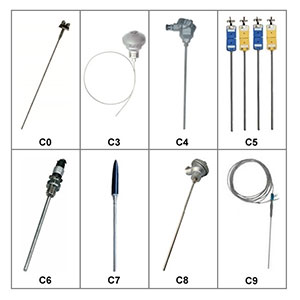What is a Thermocouple?
Thermocouple is a commonly used temperature measuring element in temperature measurement instruments. This temperature sensor directly measures temperature and converts the temperature signal into a thermoelectric electromotive force signal, which is then converted into the temperature of the measured medium through electrical instruments (secondary instruments). The appearance of various thermocouples is often very different due to needs, but their basic structure is generally the same. They are usually composed of main parts such as thermal electrodes, insulation sleeve protection tubes, and junction boxes, and are usually used in conjunction with display instruments, recording instruments, and electronic regulators.
In temperature measurement, thermocouples are widely used, with many advantages such as simple structure, convenient manufacturing, wide measurement range, high accuracy, small inertia, and easy remote transmission of output signals. In addition, there is no need for an external power supply during measurement, making it very convenient to use. Therefore, it is often used to measure the temperature of gases or liquids in furnaces and pipelines, as well as the surface temperature of solids.
Structure Form of Thermocouples
The structural forms of thermocouples include ordinary thermocouples, armored thermocouples, and thin film thermocouples.
Although there are many types of thermocouples, they are usually composed of metal thermal electrodes, insulators, protective sleeves, and wiring devices.
Type of Thermocouples
- Temperature Range: -270°C to 1,371°C (-454°F to 2,500°F)
- Widely used for general-purpose applications.
- Good accuracy and sensitivity.
- Resistant to oxidation, which makes it suitable for high-temperature measurements.
- Temperature Range: -210°C to 760°C (-346°F to 1,400°F)
- Often used in industrial and scientific applications.
- Good for low-temperature measurements.
- Susceptible to magnetic interference.
- Temperature Range: -270°C to 400°C (-454°F to 750°F)
- Suitable for applications that require a wide temperature range and good accuracy.
- Excellent for sub-zero and cryogenic measurements.
- Temperature Range: -270°C to 1,000°C (-454°F to 1,832°F)
- Offers good sensitivity and accuracy.
- Commonly used in laboratory and industrial applications.
- Temperature Range: -270°C to 1,300°C (-454°F to 2,372°F)
- Provides good accuracy and reliability.
- Resistant to high-temperature corrosion.
- Temperature Range: 0°C to 1,820°C (32°F to 3,308°F)
- Used for very high-temperature applications.
- Excellent stability and linearity.
- Expensive and less common.
- Temperature Range: 0°C to 1,768°C (32°F to 3,214°F)
- Designed for high-temperature applications.
- Highly accurate and stable.
- Often used in industrial furnaces and aerospace.
Advantages of Thermocouples
Thermocouples are commonly used temperature measuring components in industry, with the following advantages:
- Simple structure and convenient use.
- It has high accuracy, stability, and reproducibility.
- Wide temperature measurement range.
- Reliable performance and high mechanical strength.
- Long service life and easy installation.
- Thermocouple itself can generate voltage, do not need external drive power, which is a typical active sensor.
Installation Requirements for Thermocouples
The installation of thermocouples should be noted to facilitate accurate temperature measurement, safety, reliability, and convenient maintenance, without affecting equipment operation and production operations. To meet the above requirements, the following points should be noted when selecting the installation location and insertion depth of thermocouples and thermal resistors:
- In order to ensure sufficient heat exchange between the measuring end of the thermocouple and the measured medium, the position of the measuring point should be reasonably selected to avoid installing thermocouples or thermal resistors near the dead corners of valves, elbows, pipelines, and equipment as much as possible;
- If it is not necessary to install it at the elbow, try to install it at the top in the direction of the fluid as much as possible, rather than at the top in the direction of the fluid.
Thermocouples with protective sleeves have heat transfer and heat dissipation losses. In order to reduce measurement errors, thermocouples and thermal resistance thermocouples should have sufficient insertion depth:
a. For thermocouples used to measure the fluid temperature at the center of a pipeline, the measuring end should generally be inserted into the center of the pipeline (vertically or obliquely installed). If the diameter of the pipeline for the measured fluid is 200 millimeters, the insertion depth of the thermocouple or thermal resistor should be selected as 100 millimeters;
b. For temperature measurement of high-temperature, high-pressure, and high-speed fluids (such as main steam temperature), in order to reduce the resistance of the protective sleeve to the fluid and prevent the protective sleeve from breaking under the action of the fluid. The depth of the shallow inserted thermocouple protective sleeve inserted into the main steam pipeline should not be less than 810 times the diameter of the probe rod. As for our conventional 6mm probe, it is often recommended to have a minimum insertion depth of 50mm;
c. If it is necessary to measure the temperature of the flue gas inside the flue, although the flue diameter is 4m,then the insertion depth of the thermocouple or thermal resistor is 1m;
d. When the insertion depth of the measuring element exceeds 1m, it should be installed vertically as much as possible, or a support frame and protective sleeve should be added.
Overall, thermocouples are a popular choice for temperature measurement in many applications due to their versatility, ruggedness, and wide temperature range capabilities.

